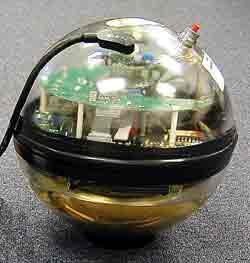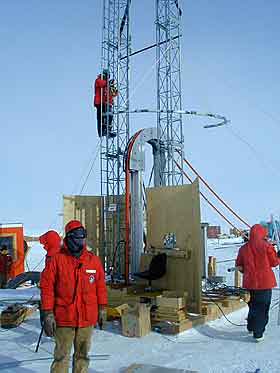| The cosmos has turned out to be a wilder place
than anyone imagined just a few years ago. Massive black holes power
numerous galactic centers that spew jets of matter and energy, and black
holes are the prime suspects in bursts of gamma rays that momentarily
flood the sky with the light of millions of billions of suns.
Astronomy in this energetic new frontier calls for new ways of seeing.
Neutrinos are almost ideal. While intervening dust clouds and the inner
regions of many cosmic accelerators absorb or scatter photons -- from
visible light through the highest energy gamma rays and every wavelength
between -- neutrinos are immune to both electromagnetism and the strong
nuclear force; they can escape from anything except the inside of a black
hole itself.
Unfortunately neutrinos are just as hard to catch as they are to stop.
Robert Stokstad of Lawrence Berkeley National Laboratory's Nuclear Science
Division notes that "resolving point sources of neutrinos at cosmic
distances will require detectors that encompass about a cubic kilometer of
ordinary water or ice."
Stokstad credits David Nygren of the Physics Division with encouraging
the Lab to enter high-energy neutrino astrophysics after attending a
Caltech conference in 1994. Stokstad was one of a group of scientists who
formed the Km3 group that year, within the Lab's multidisciplinary
Institute for Nuclear and Particle Astrophysics. Research into the
requirements of an effective cosmic-neutrino "telescope" has
been supported by the Department of Energy through the Lab's Directed
Research and Development program, and recently through the Physics
Division and the National Science Foundation as well.
Two relatively small precursors of such a kilometer-scale telescope are
now operating: AMANDA in the South Polar ice and BAIKAL in Siberia's Lake
Baikal. Two more, NESTOR in Greece and ANTARES in France, are under
development in the Mediterranean.
All four use arrays of photomultiplier tubes, either suspended from
cables or supported on underwater structures, to detect flashes of faint
blue Cerenkov radiation emitted when a muon streaks past at faster than
the speed of light in water.
Muons are generated in great numbers when cosmic rays strike atoms in
the Earth's atmosphere above the detector. When these penetrate the ice or
water above the detector they leave downward tracks. Rare, upward-going
muon tracks, produced by neutrinos traveling all the way through the
planet, must be distinguished from the millions-of-times more numerous
down-going muons.
By accurately reconstructing a muon's track from the arrival times of
its Cerenkov radiation at several modules, the neutrino that created it
can be traced back to its area of origin.
"Expanding an existing detector array to a cubic-kilometer
telescope will not be a straightforward scale-up," Stokstad points
out. In present technology, the analog signals from a photomultiplier tube
are sent by optic fiber or electrical cable to a central location for data
processing. A typical AMANDA string, for example, carries more than three
dozen optical modules -- photomultipliers housed in glass spheres --
spaced along the bottom half of a two-kilometer-long cable.
"By the time a copper cable carries the signal to the data
processor, the electrical pulse has spread out and attenuated," says
Stokstad. "Fiber optics solves this -- the signal goes in with a
sharp rise and comes out that way -- but a fiber cable is expensive, and
the connection to the module can deteriorate or break when the glass
sphere becomes frozen in the ice."
 |

IN BERKELEY LAB'S DIGITAL OPTICAL MODULE, THE EVACUATED GLASS
SPHERE CONTAINS NOT ONLY A PHOTOMULTIPLIER TUBE TO DETECT FLASHES OF
CERENKOV RADIATION (BOTTOM HALF) BUT ELECTRONICS THAT CAN BEGIN
PROCESSING THE SIGNALS IN PLACE, BEFORE DATA IS SENT TO THE SURFACE
(TOP HALF).
|
The Km3 group came up with a new architecture for processing signals in
a neutrino telescope, inspired by the example of a custom chip that had
been developed by Stuart Kleinfelder of the Engineering Division. Rather
than sending torrents of raw data to the surface in analog form, the data
processing could begin down in the ice, done by fast electronics inside
the module.
The guts of the new optical module, built around a chip whose final
version would be called an "analogue transient waveform
digitizer," would slice the photomultiplier's output pulse into
sections of one to 10 nanoseconds each, then stamp a time signal on the
resulting waveform. Only if modules nearby on the string recorded similar
pulses within a microsecond of one another would the pulse be considered a
genuine hit and subsequently processed. Data transmission to the surface
would occur only through robust digital protocols using tough, relatively
inexpensive copper cable.
Stokstad explains that most individual pulses are just noise, caused in
part by random emission of photoelectrons from the cathode of the
photomultiplier tube. "False signals come from this 'dark current'
and also, as we discovered, from radioactive decay of potassium in the
glass of the sphere" -- and even from the temporary fluorescence of
the plastic circuit board itself.
Since the noise is random, however, it is easily eliminated by
comparing detection times of signals among modules near each other on the
string. This comparison, called a "local coincidence," can be
done on the surface, says Stokstad, "but with digital modules the
electronics leave the noise buried in the ice."
In an early collaboration with NASA's Jet Propulsion Laboratory, the
Km3 group tested the idea at AMANDA's South Pole location using two
modules, which confirmed the principle by sending digitized waveforms to
the surface. In 1997 the Km3 group teamed with the local AMANDA group, led
by Buford Price of the University of California at Berkeley and supported
by the NSF.
AMANDA was planning to deploy six strings of modules during the
Antarctic summer of 1999-2000, which would bring the total number of
strings to 19. In November 1998, AMANDA and the Km3 group decided to
include a full string of digital optical modules, or DOMs, in this
deployment schedule.
"Our initial schedule called for a prototype by February of
1999," says Stokstad, who became the DOM project manager. "We
were a little optimistic."
The first prototype was finally finished in April; after intensive
testing, a second was finished in late June. Remarkably, by mid-October,
50 production printed circuit boards were finished, and by the end of
November the circuit boards, wiring, and photomultiplier tubes --
"potted" in clear gel -- of all 42 modules needed for Antarctica
had been assembled and sealed in their spheres at AMANDA's facilities at
the University of Wisconsin. The finished DOMs were on their way south
almost immediately.
Stokstad delivered the first two personally, arriving December 13, two
weeks ahead of the main shipment, on his first trip to the South Pole.
Other members of the Km3 group were soon on hand to send the full string
into the ice, including the DOM's principal designer, Jozsef Ludvig of
Engineering, along with Gerald Przybylski of the Physics Division, who
brought the final two modules which had been left at Berkeley Lab for
further tests, and Chuck McParland of Information and Computing Sciences.
"The first tests with the actual electrical cable were only
possible after arriving at the Pole. After we hooked up several modules to
this cable, we decided that some adjustments were necessary to improve the
digital communication," says Stokstad. "That meant all the
spheres had to be unsealed and opened, the boards had to be removed,
modified, and replaced, and the spheres pumped out again and
vacuum-sealed" -- all while working in a cramped shack near the drill
site. With long hours and steady work, the 41 modules slated for the
string had been reassembled by the time the AMANDA drilling crew was
ready.
 |

TO BURY STRINGS OF DETECTORS DEEP IN THE ANTARCTIC ICE,
HOT WATER IS FORCED THROUGH A NOZZLE TO MELT A TWO-KILOMETER-DEEP
SHAFT, A DRILLING PROCESS THAT TAKES THREE OR FOUR DAYS.
|
Hot water forced through a nozzle melts a two-kilometer-deep hole in
the ice, a process that takes three or four days. The water standing in
the hole freezes solid in 36 hours or less, and the whole string of
modules must be in place before any part of the hole gets too narrow.
"As the string went in we hooked each module into position, made
the electrical connections -- using a hot-air gun to warm the plastic --
plugged it in, booted it up, and checked that it talked," says
Stokstad. "Because we also had the standard optical fiber hook-ups on
the string, it took us 15 or 20 minutes for each module, but in 12 hours
the whole string was in place. We made 42 modules and deployed 41 in the
ice."
The ice hardened and pressure increased on the glass spheres -- the
same kind used for deploying sensors at depths up to four kilometers in
the open ocean -- while, Stokstad says, "we waited with bated breath
to see how many would talk."
Eventually only one module failed, not because of its digital
electronic components but because of a bad photomultiplier tube base.
There was also one broken link in the fiber optics, which had been added
to the string at AMANDA's request so that data from the digital modules
could be processed in the same way as all the other AMANDA data. By
extraordinary luck this was the same module, the one with the failed tube
base.
Unlike other AMANDA strings, each module on the DOM string is
separately programmable, and -- because of communication systems designed
by McParland -- not just from Antarctica: not only the operating software
but also the more fundamental "firmware" of each buried computer
can be reprogrammed right from Berkeley Lab.
John Jacobsen and Azriel Goldschmidt of the Physics Division were also
at the Pole and implemented the remote communications and operations;
since their return they have been collecting and analyzing a steady stream
of data from the digital modules now permanently frozen into the Antarctic
ice.
While some features, such as local coincidence, still await
implementation, the so-far unbounded success of the DOMs makes the future
of neutrino astronomy look that much brighter.
The Lab's Km3 group, in collaboration with other astrophysicists and
astronomers, have recently put forth a proposal to the National Science
Foundation for an expansion of AMANDA dubbed "IceCube." In
addition to those named above, Km3 includes senior members William
Chinowsky, Dave Nygren, and George Smoot of Physics Division, Doug Lowder
of UCB and SSL, Jodi Lamoureux of NERSC and Howard Matis of Nuclear
Sciences.
Photo credits: The photos are by Robert Stokstad.
Additional Information:
|


